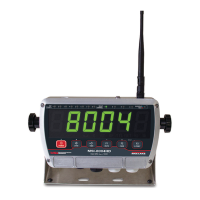What does it mean when Lo Batt is blinking on my Rice Lake Monitor?
- Ccrystal62Sep 15, 2025
If 'Lo Batt' is blinking on your Rice Lake Monitor, it indicates that the battery is low. Recharge the battery.

What does it mean when Lo Batt is blinking on my Rice Lake Monitor?
If 'Lo Batt' is blinking on your Rice Lake Monitor, it indicates that the battery is low. Recharge the battery.
What to do if my Rice Lake MSI-8004HD Measuring Instruments does not respond to weight/tension changes?
If your Rice Lake Measuring Instruments isn't responding to weight or tension changes, the issue could be due to the unit being out of calibration (calibrate the unit), a faulty load cell (replace the load cell), or a problem with the load cell connector (check connectors and wires).
How to fix a Rice Lake Measuring Instruments display that drifts?
If the display on your Rice Lake Measuring Instruments drifts, it could be because AZM (Auto 0) is turned off (turn AZM on). It may also happen due to rapid temperature changes, like moving the scale from indoors to outdoors (wait until the scale temperature has stabilized).
What to do if my Rice Lake MSI-8004HD Measuring Instruments displays a large weight/tension error?
If your Rice Lake Measuring Instruments shows a large weight/tension error, it might be because the scale wasn't zeroed before the load was lifted (zero the scale with no load attached). Another reason may be confusion due to lb/kg units (select proper units), or the unit requires recalibration (recalibrate the unit).
Why does my Rice Lake MSI-8004HD toggle between Error and Load?
If your Rice Lake Measuring Instruments toggles between 'Error' and 'Load', it's likely because the load exceeds capacity (reduce tension immediately) or there is a faulty load cell or wiring (check load cell and load cell wiring).
What to do if my Rice Lake Monitor does not respond to weight/tension changes?
If your Rice Lake Monitor does not respond to weight or tension changes, it could be out of calibration, so calibrate the unit. Another possibility is a faulty load cell, in which case you should replace it. Also, check the load cell connectors and wires.
Why does my Rice Lake Monitor unit turn on, then immediately off?
If your Rice Lake Monitor turns on and then immediately off, it is likely because the battery is low. Recharge the battery to resolve this issue.
What to do if the Rice Lake Monitor display over ranges below 100% of capacity?
If the Rice Lake Monitor display over ranges below 100% of capacity, it may be because tared weight/tension is added to the load to determine the overload point. Return to gross tension mode to fix this. It could also be that the zero requires adjustment, so rezero the scale. If too much weight/tension has been zeroed, rezero the scale as well.
Why do the setpoint lights blink on my Rice Lake MSI-8004HD Measuring Instruments?
If the setpoint lights blink on your Rice Lake Measuring Instruments, it means the set point is enabled and the trigger point has been reached. If set points are not needed, disable them.
How to fix a Rice Lake MSI-8004HD Measuring Instruments that will not zero?
If your Rice Lake Measuring Instruments will not zero, ensure the system is stable by waiting for the stable symbol to turn on. You can also increase filtering for more stability. If the zero is out of range, this may be due to limited zero range; try reducing the tension or using Tare instead.
| Brand | Rice Lake |
|---|---|
| Model | MSI-8004HD |
| Category | Measuring Instruments |
| Language | English |
Lists key features of the MSI-8004HD RF Remote Display.
Details FCC compliance information for the device.
Outlines essential safety definitions and general safety guidelines for operation.
Describes the front panel layout, including keypad and annunciator functions.
Covers unpacking, getting started, mounting, and opening the enclosure for installation.
Details wiring, power supply, radio module, ScaleCore card, and antenna installation.
Instructions for installing the tilt stand and battery options for extended operation.
Provides visual breakdowns and part lists for different generations of the remote display.
Covers powering on/off, zeroing, and taring the scale for accurate measurements.
Details printing capabilities and how to use programmable function keys for various operations.
Explains modes like Total, Net/Gross, Peak Hold, Units, and High Resolution Test.
Explains how to navigate and access the device's setup menus for configuration.
Details how to program and customize the function keys for specific operations.
Configures power-saving features like auto-off and sleep, along with display brightness and color.
Sets up operational thresholds (setpoints) and configures relay outputs for control systems.
Configures settings for operating remote scales and adjusting the weight filter for stability.
Sets up how the device accumulates and totals weighments from multiple sources.
Step-by-step guides for routine and initial calibration of the scale.
Guidelines on capacity, resolution, and setting up calibration standards.
Alternative calibration methods and gravity compensation settings for accurate readings.
Instructions for resetting the load cell calibration and returning to factory settings.
Navigating the communications menu and configuring printer output settings.
Configuring RF network settings and setting up communication with remote devices.
Managing multiple sensors, setting scanlist IDs, and configuring load totaling modes.
Setting the device's clock and understanding the hardware for communication ports.
Configuring relay outputs and selecting appropriate antenna options for RF communication.
Details on operating the Rugged Remote, including power, zero, and programmable keys.
Discusses operational considerations like signal conflicts and jamming for the Rugged Remote.
Provides solutions for common problems and lists error codes for diagnosis.
Information on safety service counters and the physical dimensions of the device.
Guides for updating device firmware and replacing the coin-cell battery for RTC.